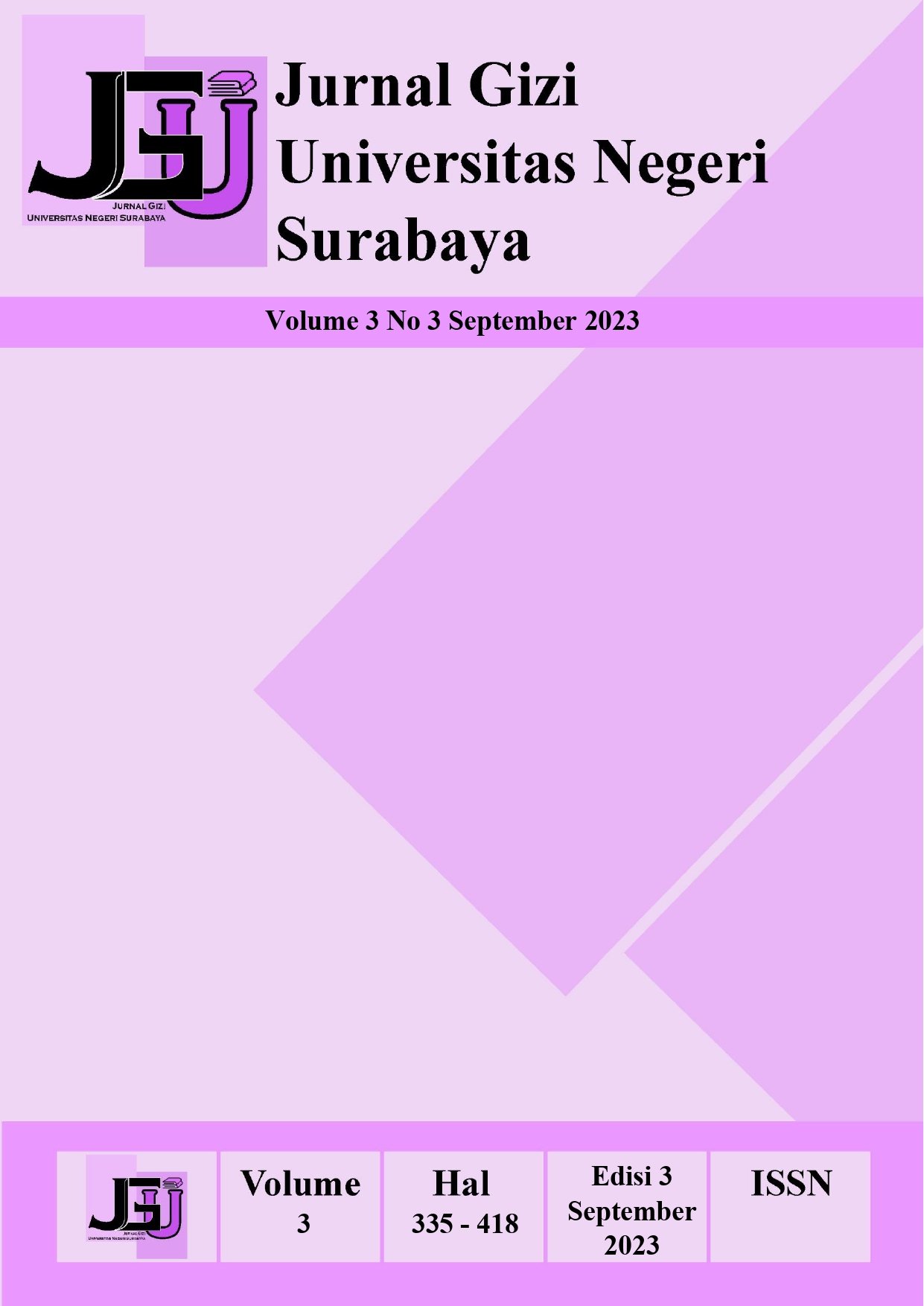THE EFFECT OF PROPORTION OF RED BEAN FLOUR AND SOYBEAN ON ACCEPTABILITY AND NUTRITIONAL CONTENT OF SNACK BARS AS A HIGH PROTEIN DIET SNACK
Keywords:
Snack bar, Red Bean Flour, Soybean, High ProteinAbstract
Snack bars are snacks in the form of bars made from cereals or nuts. Snack bars are a type of healthy snack that contains high protein nutrients. The purpose of this study was to determine the effect of the proportions of red bean flour and soybean on acceptability (color, aroma, taste, and texture) and nutritional content (energy, carbohydrates, protein, and fat) in the best snack bar formula as a high protein diet. This study used a true experimental study with a completely randomized design with 3 treatments proportion red bean flour and soybean (25% : 75%, 50% : 50%, 75% : 25%) by weight of the basic ingredients of oats in the manufacture of snack bars. The panelists in this study were semi-trained panelists consisting of 35 people. Data acceptance results were analyzed using non-parametric statistics, namely Kruskal Wallis. The results of acceptance which have a significant effect, further analysis is carried out with the Mann Whitney test to find out the best results. The proportion of red bean flour and soybean has an effect on the acceptability of aroma and texture but does not affect the color and taste of the snack bar. The best snack bar formula is with a proportion of 50% red bean flour and 50% soy beans. The test results for the best formula nutritional content per 100 grams of snack bar were energy of 365.67 kcal, carbohydrates 28.15%, protein 20.10%, and fat 19.19%.Downloads
References
Alwi, H., Damat & Putri, D. N., 2021. Karakteristik Fisikokimia dan Organoleptik Snack Bar Berbasis Tepung Ampas Tahu, Tepung Kacang Merah (Phaseolus vulgaris L.) dan Kacang Kedelai (Glycine max.). Food Technology and Halal Science Journal, pp. 23-38.
Astawan, 2004. Kandungan Gizi Aneka Bahan Makanan. Jakarta: PT. Gramedia.
Astawan, 2009. Sehat dengan Hidangan Kacang dan Biji-bijian. Jakarta: Penebar Swadaya.
Astawan, 2010. [Online]
Available at: Http://www.Cbn.Net.id.
[Accessed 25 Maret 2022].
Binalopa, T., Amir, B. & Julyaningsih, A., 2023. Pengaruh Penambahan Tepung Kacang Merah (Phaseolus vulgaris L.) dan Tepung Labu Kuning (Cucurbia moschata) pada Pembuatan Kue Kering. Jurnal Pertanian Berkelanjutan, 11(1), pp. 94-102.
Fajri, R., Basito & Muhammad, D. R. A., 2013. Karakteristik Fisikokimia dan Organoleptik Food Bars Labu Kuning (Cucurbita maxima) Dengan Penambahan Tepung Kedelai dan Tepung Kacang Hijau Sebagai Alternatif Produk Pangan Darurat. Jurnal Teknologi Hasil Pertanian, VI(2), pp. 103-110.
Jauhari, M., Sulaeman, A., Riyadi, H. & Ekayanti, I., 2014. Pengembangan Formula Minuman Olahraga Berbasis Tempe Untuk Pemulihan Kerusakan Otot. AGRITECH, 34(3), pp. 285-290.
Koswara, S., 1992. Teknologi Pengolahan Kedelai Menjadikan Makanan Bermutu. Jakarta: Pustaka Sinar Harapan.
Kurnianingtyas, A., Ninna, R. & Andrei, R., 2014. Pengaruh Penambahan Tepung Kacang Merah Terhadap Daya Terima, Kadar Protein, dan Kadar Serat Pada Bakso Jantung Pisang. E-Jurnal Pustaka Kesehatan, 2(3), pp. 485-491.
Ladamay, N. A. & Yuwono, S. S., 2014. Pemanfaatan Bahan Lokal Dalam Pembuatan Foodbars (Kajian Rasio Tapioka : Tepung Kacang Hijau Dan Proporsi CMC). Malang: Jurusan Teknologi Hasil Pertanian, Universitas Brawijaya Malang.
Mayasari, R., 2015. Kajian Karakteristik Biskuit Yang Dipengaruhi Perbandingan Tepung Ubi Jalar (Ipomea batatas L.) dan Tepung Kacang Merah (Phaseolus vulgaris L.). Bandung: Universitas Pasundan.
Nataliningsih, 2007. Analisis Sifat Fisiko-Kimia Pengolahan BMC Instan Dalam Rangka Penanggulangan Gizi Buruk di Pedesaan. Bandung: Universitas Bandung Raya.
Pangastuti, H. A., Affandi, D. R. & Ishartani, D., 2013. Karakteristik Sifat Fisik dan Kimia Tepung Kacang Merah (Phaseolus vulgaris L.) dengan Beberapa Perlakuan Pendahuluan. Jurnal of Food Science, 2(1), pp. 20-29.
Perwita, E. S., Suhartiningsih, Pangesthi, L. T. & Anna, C., 2021. Proporsi Tepung Kacang Merah (Phaseolus vulgaris L.) dan Bubuk Daun Kelor (Moringa oleifera L.) Terhadap Sifat Organoleptik Snack Bar Labu Kuning. Jurnal Tata Boga, 10(2), pp. 303-313.
Pontang, G. S. & Wening, D. K., 2021. Formulasi Snack bar Berbahan Dasar Tepung Mocaf Dan Tepung Kacang Merah Sebagai Makanan Selingan Bagi Atlet. Journal of Nutrition College, 10(3), pp. 218-226.
Rahayu, W. P., 1998. Penuntun Praktikum Penilaian Organoleptik. Bogor: Jurusan Teknologi Pangan dan Gizi Fakultas Teknologi Pertanian, Institut Pertanian Bogor.
Siregar, L. N. S., Harun, N. & Rahmayuni, 2017. Pemanfaatan Tepung Kacang Merah dan Salak Padang Sidimpuan (Salacca sumatrana R.) Dalam Pembuatan Snack Bar. Jurnal Online Mahasiswa, 4(1).
Winiastri, D., 2021. Formulasi Snack Bar Tepung Sorgum (Sorghum bicolor (L.) moench) dan Labu Kuning (Cucurbita moschata) Ditinjau dari Uji Organoleptik dan Uji Aktivitas Antioksidan. Jurnal Inovasi Penelitian, 2(2), pp. 751-763.
Wiranata, I. G. A. G., Puspaningrum, D. H. D. & Kusumawati, I. G. A. W., 2017. Formulasi dan Karakteristik Nutrimat Bar Berbasis Tepung Kacang Kedelai (Glycine max L.) dan Tepung Kacang Merah (Phaseolus vulgaris L.) Sebagai Makanan Pasien Kemoterapi. Jurnal Gizi Indonesia, 5(2), pp. 133-139.
Zuyina, H., 2017. Beautynesia. [Online]
Available at: https://www.beautynesia.id/wellness/yuk-coba-membuat-snack-sehat-dan-lezat-granola-bar-di-rumah/b-121185
[Accessed 27 Maret 2022].
Downloads
Published
How to Cite
Issue
Section
 Abstract views: 573
,
Abstract views: 573
, PDF Downloads: 1059
PDF Downloads: 1059


